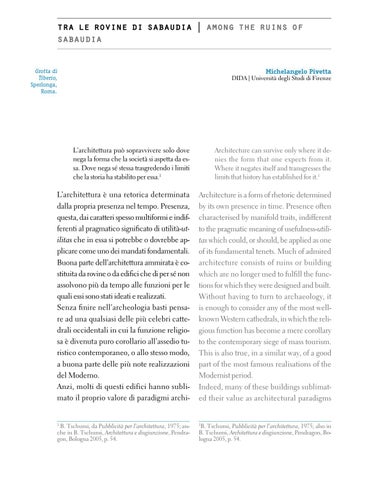tra le rovine di sabaudia | among the ruins of sabaudia Michelangelo Pivetta
Grotta di Tiberio, Sperlonga, Roma.
DIDA | Università degli Studi di Firenze
L’architettura può sopravvivere solo dove nega la forma che la società si aspetta da essa. Dove nega sé stessa trasgredendo i limiti che la storia ha stabilito per essa.1
Architecture can survive only where it denies the form that one expects from it. Where it negates itself and transgresses the limits that history has established for it.1
L’architettura è una retorica determinata dalla propria presenza nel tempo. Presenza, questa, dai caratteri spesso multiformi e indifferenti al pragmatico significato di utilità-utilitas che in essa si potrebbe o dovrebbe applicare come uno dei mandati fondamentali. Buona parte dell’architettura ammirata è costituita da rovine o da edifici che di per sé non assolvono più da tempo alle funzioni per le quali essi sono stati ideati e realizzati. Senza finire nell’archeologia basti pensare ad una qualsiasi delle più celebri cattedrali occidentali in cui la funzione religiosa è divenuta puro corollario all’assedio turistico contemporaneo, o allo stesso modo, a buona parte delle più note realizzazioni del Moderno. Anzi, molti di questi edifici hanno sublimato il proprio valore di paradigmi archi-
Architecture is a form of rhetoric determined by its own presence in time. Presence often characterised by manifold traits, indifferent to the pragmatic meaning of usefulness-utilitas which could, or should, be applied as one of its fundamental tenets. Much of admired architecture consists of ruins or building which are no longer used to fulfill the functions for which they were designed and built. Without having to turn to archaeology, it is enough to consider any of the most wellknown Western cathedrals, in which the religious function has become a mere corollary to the contemporary siege of mass tourism. This is also true, in a similar way, of a good part of the most famous realisations of the Modernist period. Indeed, many of these buildings sublimated their value as architectural paradigms
B. Tschumi, da Pubblicità per l’architettura, 1975; anche in B. Tschumi, Architettura e disgiunzione, Pendragon, Bologna 2005, p. 54.
1 B. Tschumi, Pubblicità per l’architettura, 1975; also in B. Tschumi, Architettura e disgiunzione, Pendragon, Bologna 2005, p. 54.
1
